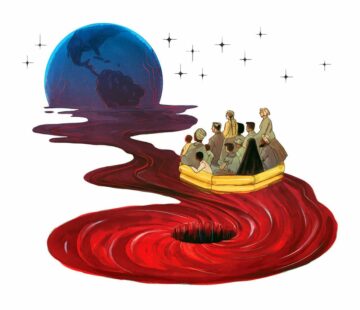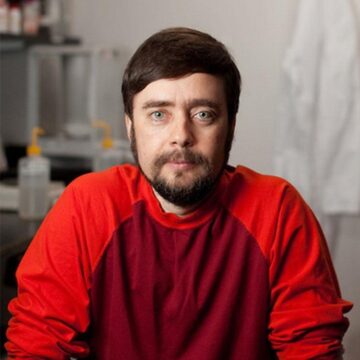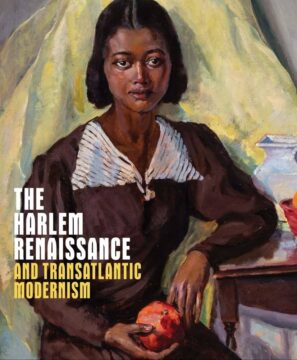Category: Recommended Reading
Helen Vendler (1933 – 2024) Poetry Critic
Mike Pinder (1941 – 2024) Keyboardist For The Moody Blues
Saturday, April 27, 2024
We Broke the World
Roy Scranton in The Baffler:
 TAKE A GOOD LOOK at yourself in the mirror. Really go look. Observe closely the skin over the cheekbones, the chin, the lips, the cunning little teeth. See the ears and nose, the smooth forehead, the hair and eyebrows. Admire what an intelligent beast you are!
TAKE A GOOD LOOK at yourself in the mirror. Really go look. Observe closely the skin over the cheekbones, the chin, the lips, the cunning little teeth. See the ears and nose, the smooth forehead, the hair and eyebrows. Admire what an intelligent beast you are!
Consider those intelligent beast eyes looking back at you: the tear ducts and the sclera, the delicate fringe of lash, the striated iris’s ring around the empty pupil, that aperture through which the light reflecting off the mirror enters, striking the retina, to be transformed into the image of yourself you’re now watching, an illusion your brain has put together from nerve impulses, a representation of reality unfolding, with a slight delay, after reality itself. If your brain is working within the usual parameters and you haven’t recently taken any psychoactive drugs, though, you won’t generally perceive any temporal gap. How could you? It is your perception itself that lags. You are not looking at “yourself,” not really, but rather at a construct rendered in your mind. For most practical purposes, however, this epistemological gap between reality and perception is only a problem for scientists and philosophers. You know you exist, and unless you’re high, that’s usually good enough.
More here.
How bioelectricity could regrow limbs and organs
From UChicago News:
 Michael Levin: Pretty much everything, birth defects, traumatic injury, aging, degenerative disease, cancer, all of these things boil down to the problem of a group of cells not knowing how or not being able to build the right thing. If we have the answer to this, how do you communicate an anatomical goals to a collection of cells? You could fix all of these things.
Michael Levin: Pretty much everything, birth defects, traumatic injury, aging, degenerative disease, cancer, all of these things boil down to the problem of a group of cells not knowing how or not being able to build the right thing. If we have the answer to this, how do you communicate an anatomical goals to a collection of cells? You could fix all of these things.
Paul Rand: We have this assumption that our cells are mindless, that they’re hardwired to only do a limited set of things, but Levin isn’t so sure.
Michael Levin: We sort of think that, “Okay, so there’s the chemistry, it’s sort of unfolds and well, what else could it possibly do? It’s just following the laws of chemistry?” That robustness, it actually lulls us into a very false sense of simplicity because, for example, if you take a human or many other kinds of embryos and you cut them in half, you don’t get two half bodies the way that you would get if you cut a car or a computer or something else in half, you get two perfectly normal monozygotic twins, and the way that happens is because that collection of cells can tell that half of it is missing and it can tell that it needs to rebuild what’s missing? That process right there is literally a kind of intelligence, and once you’ve understood that the body, much like the brain, is a collective intelligence and the morphogenesis is the behavior of that collective intelligence, you can start to ask all sorts of interesting questions. How can you train it? How do you know what it’s thinking? How do you communicate with it?
Paul Rand: Levin thinks he may have found the answers to those questions, bioelectricity.
More here.
Saturday Poem
Learning to Read
By four I knew what my mother must have known
immediately. I was more trouble
than I was worth. She’d lie down for a nap and there I’d be
buzzing around her, thinking
that I had a right to push my nose into everything.
That’s how I learned: bumping into things
like a fly who keeps asking the same question
of glass. At seven I hovered over words
on cereal boxes, candy wrappers,
my grandmother’s romance novels. My brother’s
adventure books. They all tasted
like delicacies, like the crust
of fat off the roast, dollop
of butter, heel of bread, smear of gooseberry jam,
sweet, brown rot
of a banana, still-soft gum with a little peppermint
hidden in it. I was that hungry.
Leftovers, scraps, carrion. As I turned the pages,
I picked my nose, studied scabs,
the blue grit I pried from under my nails,
the bit of wax on my fingertip,
reading the smudged ink
of my body, its own dark alphabet.
I didn’t care what I feasted on
as long as I feasted.
by Christopher Bursk
from The First Inhabitants of Arcadia
University of Arkansas Press, 2006
Friday, April 26, 2024
Terry Eagleton: Where Does Culture Come From?
How Harlem Saw Itself
Clifford Thompson at Commonweal:
 “For generations in the mind of America, the Negro has been more of a formula than a human being—a something to be argued about, condemned or defended, to be ‘kept down,’ or ‘in his place,’ or ‘helped up,’ to be worried with or worried over, harassed or patronized, a social bogey or a social burden.” So wrote Alain Locke in the anthology The New Negro (1925), often considered the founding document of the Harlem Renaissance, the artistic movement of which Locke is generally recognized as intellectual impresario. “The thinking Negro even has been induced to share this same general attitude, to focus his attention on controversial issues, to see himself in the distorted perspective of a social problem. His shadow, so to speak, has been more real to him than his personality.”
“For generations in the mind of America, the Negro has been more of a formula than a human being—a something to be argued about, condemned or defended, to be ‘kept down,’ or ‘in his place,’ or ‘helped up,’ to be worried with or worried over, harassed or patronized, a social bogey or a social burden.” So wrote Alain Locke in the anthology The New Negro (1925), often considered the founding document of the Harlem Renaissance, the artistic movement of which Locke is generally recognized as intellectual impresario. “The thinking Negro even has been induced to share this same general attitude, to focus his attention on controversial issues, to see himself in the distorted perspective of a social problem. His shadow, so to speak, has been more real to him than his personality.”
However, Locke added, “By shedding the old chrysalis of the Negro problem we are achieving something like a spiritual emancipation.” That emancipation largely took the form of creative expression—the literature, music, and visual art that flowered in the 1920s and ’30s and reflected the experiences of millions of African Americans who, seeking opportunity, migrated from the South to the cities of the North and Midwest.
more here.
The Glorious Proletarian Theater of Pro Wrestling
Kim Kelly at The Nation:
 Modern pro wrestling branches off from vaudeville, loops back through the circus, launches off a theater balcony, and takes a detour past Muscle Beach before hammering together a space all its own. It’s held onto its malleability and perennial status as a home for misfits and weirdos who don’t quite fit in anywhere else. As an accessible working-class art form, it’s become a magnet for generations of performers who came into wrestling with little more than a dream and a high pain threshold. It’s not a coincidence that pro wrestling is one of the few theatrical arts in which a performer can still succeed wholly on their own merits. You don’t need rich parents or a degree from a prestigious institution to don the tights and become a star; it’ll still cost you and the view from backstage isn’t always pretty, but the barrier to entry is far lower. How do you get to Wrestlemania? Practice.
Modern pro wrestling branches off from vaudeville, loops back through the circus, launches off a theater balcony, and takes a detour past Muscle Beach before hammering together a space all its own. It’s held onto its malleability and perennial status as a home for misfits and weirdos who don’t quite fit in anywhere else. As an accessible working-class art form, it’s become a magnet for generations of performers who came into wrestling with little more than a dream and a high pain threshold. It’s not a coincidence that pro wrestling is one of the few theatrical arts in which a performer can still succeed wholly on their own merits. You don’t need rich parents or a degree from a prestigious institution to don the tights and become a star; it’ll still cost you and the view from backstage isn’t always pretty, but the barrier to entry is far lower. How do you get to Wrestlemania? Practice.
Despite all of that, pro wrestling still doesn’t get the kind of respect it deserves as a unique global art form.
more here.
Friday Poem
God Says to Me
I asked God if it was ok to be melodramatic
and she says yes
I asked her if it was ok to be short
and he said sure it is
I asked her if I could wear nail polish
or not wear nail polish
and he said honey
she calls me that sometimes
she said you can do just exactly
what you want to
Thanks God I said
And is it even okay if I don’t paragraph
my letters
Sweetcakes God said
who knows where she picked that up
what I’m telling you is
Yes Yes Yes
by Kaylin Haught
from Poetry 180
Random House, 2003
Insects and Other Animals Have Consciousness
Dan Falk in Quanta Magazine:
 In 2022, researchers at the Bee Sensory and Behavioral Ecology Lab at Queen Mary University of London observed bumblebees doing something remarkable: The diminutive, fuzzy creatures were engaging in activity that could only be described as play. Given small wooden balls, the bees pushed them around and rotated them. The behavior had no obvious connection to mating or survival, nor was it rewarded by the scientists. It was, apparently, just for fun.
In 2022, researchers at the Bee Sensory and Behavioral Ecology Lab at Queen Mary University of London observed bumblebees doing something remarkable: The diminutive, fuzzy creatures were engaging in activity that could only be described as play. Given small wooden balls, the bees pushed them around and rotated them. The behavior had no obvious connection to mating or survival, nor was it rewarded by the scientists. It was, apparently, just for fun.
The study on playful bees is part of a body of research that a group of prominent scholars of animal minds cited today, buttressing a new declaration that extends scientific support for consciousness to a wider suite of animals than has been formally acknowledged before. For decades, there’s been a broad agreement among scientists that animals similar to us — the great apes, for example — have conscious experience, even if their consciousness differs from our own. In recent years, however, researchers have begun to acknowledge that consciousness may also be widespread among animals that are very different from us, including invertebrates with completely different and far simpler nervous systems.
More here.
Cell Therapies Now Beat Back Once Untreatable Blood Cancers. Scientists Are Making Them Even Deadlier
Shelly Fan in Singularity Hub:
 Dubbed “living drugs,” CAR T cells are bioengineered from a patient’s own immune cells to make them better able to hunt and destroy cancer. The treatment is successfully tackling previously untreatable blood cancers. Six therapies are already approved by the FDA. Over a thousand clinical trials are underway. These aren’t limited to cancer—they cover a range of difficult medical problems such as autoimmune diseases, heart conditions, and viral infections including HIV. They may even slow down the biological processes that contribute to aging.
Dubbed “living drugs,” CAR T cells are bioengineered from a patient’s own immune cells to make them better able to hunt and destroy cancer. The treatment is successfully tackling previously untreatable blood cancers. Six therapies are already approved by the FDA. Over a thousand clinical trials are underway. These aren’t limited to cancer—they cover a range of difficult medical problems such as autoimmune diseases, heart conditions, and viral infections including HIV. They may even slow down the biological processes that contribute to aging.
But CAR T has an Achilles heel.
Once injected into the body, the cells often slowly dwindle. Called “exhaustion,” this process erodes therapeutic effect over time and has dire medical consequences. According to Dr. Evan Weber at the University of Pennsylvania, more than 50 percent of people who respond to CAR T therapies eventually relapse. This may also be why CAR T cells have struggled to fight off solid tumors in breast, pancreatic, or deadly brain cancers. This month, two teams found a potential solution—make CAR T cells more like stem cells. Known for their regenerative abilities, stem cells easily repopulate the body. Both teams identified the same protein “master switch” to make engineered cells resemble stem cells. One study, led by Weber, found that adding the protein, called FOXO1, revved up metabolism and health in CAR T cells in mice. Another study from a team at the Peter MacCallum Cancer Center in Australia found FOXO1-boosted cells appeared genetically similar to immune stem cells and were better able to fend off solid tumors.
More here.
Thursday, April 25, 2024
Neil Turok On The Simplicity Of Nature
A Brief History of Failed Attempts at Human Flight
Joe Fassler at Lit Hub:
 Years ago, for reasons I still don’t fully understand, I found myself writing about flight. It started as just a few paragraphs, a bit of spontaneous fiction jotted down in a notebook: a man stood on the roof of a barn, wearing a pair of enormous wings built from wood and cloth. His friend on the ground—the narrator—looked on nervously, ready to call an ambulance. And then the man jumped. Somehow, he flew.
Years ago, for reasons I still don’t fully understand, I found myself writing about flight. It started as just a few paragraphs, a bit of spontaneous fiction jotted down in a notebook: a man stood on the roof of a barn, wearing a pair of enormous wings built from wood and cloth. His friend on the ground—the narrator—looked on nervously, ready to call an ambulance. And then the man jumped. Somehow, he flew.
I still remember the surprise I felt as the scene spilled down the page. The thrill of liftoff, a human body lofted in midair. The whole thing only lasted a minute before the man swooned back to earth in a shuddering crash. He was safe, he’d done it. Hoarse, joyful shouts echoed around the field.
That scene became the seed of my novel, The Sky Was Ours, which has a similar pair of handmade wings at its center.
more here.
The Women Who Styled the French Revolution
Lucy Moore at Literary Review:
 After they were released from prison in Paris in the late autumn of 1794, both having narrowly escaped the guillotine, new bosom friends Rose de Beauharnais and Térézia Tallien found they had nothing to wear. Dressmakers and milliners had all but disappeared from a city still reeling from the Reign of Terror. In an era of desperate need and rampant inflation, a time when even the most prosperous took candles and bread with them when they went out to dinner, who could afford a silk dress, still less stays, hoops, acres of petticoats and several maids to sew you into it?
After they were released from prison in Paris in the late autumn of 1794, both having narrowly escaped the guillotine, new bosom friends Rose de Beauharnais and Térézia Tallien found they had nothing to wear. Dressmakers and milliners had all but disappeared from a city still reeling from the Reign of Terror. In an era of desperate need and rampant inflation, a time when even the most prosperous took candles and bread with them when they went out to dinner, who could afford a silk dress, still less stays, hoops, acres of petticoats and several maids to sew you into it?
The new feminine uniform they devised, making a stylish virtue of necessity, was simple, based on cotton chemises previously worn as underwear. In Liberty Equality Fashion, the art historian Anne Higonnet breaks down its creation into stages: over a period between 1794 and 1796, the multi-part formal gown became a single-part frock; sashes crept upwards from the waist to just beneath the bust; petticoats were abandoned.
more here.
‘Why didn’t I fight? Why didn’t I run?’: 10 things we learned from Salman Rushdie’s ‘Knife’
Ella Creamer in The Guardian:
 ‘At a quarter to eleven on August 12, 2022, on a sunny Friday morning in upstate New York, I was attacked and almost killed by a young man with a knife,” begins Salman Rushdie’s new memoir.
‘At a quarter to eleven on August 12, 2022, on a sunny Friday morning in upstate New York, I was attacked and almost killed by a young man with a knife,” begins Salman Rushdie’s new memoir.
The book, titled Knife, reflects on the attack at the Chautauqua Institution, where the writer was stabbed on stage shortly before giving a talk. It is the first book the Indian-born British-American author has written since the attack, which left him unable to see from his right eye.
Here are 10 things we’ve learned about the attack and Rushdie’s recovery from Knife.
More here.
NASA’s Voyager 1 spacecraft finally phones home after 5 months of no contact
Robert Lea at Space.com:
 NASA’s interstellar explorer Voyager 1 is finally communicating with ground control in an understandable way again. On Saturday (April 20), Voyager 1 updated ground control about its health status for the first time in 5 months. While the Voyager 1 spacecraft still isn’t sending valid science data back to Earth, it is now returning usable information about the health and operating status of its onboard engineering systems.
NASA’s interstellar explorer Voyager 1 is finally communicating with ground control in an understandable way again. On Saturday (April 20), Voyager 1 updated ground control about its health status for the first time in 5 months. While the Voyager 1 spacecraft still isn’t sending valid science data back to Earth, it is now returning usable information about the health and operating status of its onboard engineering systems.
Thirty-five years after its launch in 1977, Voyager 1 became the first human-made object to leave the solar system and enter interstellar space. It was followed out of our cosmic quarters by its space-faring sibling, Voyager 2, six years later in 2018. Voyager 2, thankfully, is still operational and communicating well with Earth.
The two spacecraft remain the only human-made objects exploring space beyond the influence of the sun.
More here.
Kwame Anthony Appiah on the Right—and Wrong—Way for Universities to Handle Identity
From Persuasion:
 Kwame Anthony Appiah is a British-Ghanaian philosopher, Professor of Philosophy and Law and New York University, and the “Ethicist” columnist for The New York Times Magazine.
Kwame Anthony Appiah is a British-Ghanaian philosopher, Professor of Philosophy and Law and New York University, and the “Ethicist” columnist for The New York Times Magazine.
In this week’s conversation, Yascha Mounk and Kwame Anthony Appiah discuss why universities discarded an ethic of common humanity for a new form of identitarianism; how we can recognize and respect individual and cultural diversity without making it the main factor in our interactions; and why faculty must be agents for the change they wish to see in universities.
More here.
Why a Forefather of AI Fears the Future: Brian Greene talks to Yoshua Bengio
Imagining a Free Palestine
Ahmad Ibsais in Time Magazine:
 “Where is Ahmad?” The soldier called my name while we were stopped at the last Israeli checkpoint on the way from Ramallah to Jerusalem. I am a Palestinian American. But once I’m in my ancestral homeland, I’m not an American in the eyes of Israeli authorities. I am simply Palestinian, denied the basic right to movement and pilgrimage to the Holy Land. For too long, Palestinians in the diaspora, like myself, became travelers on our soil. We tried to forget the realities of occupation in the West Bank, and that a few hours south in Gaza our brothers and sisters suffered under even more inhumane conditions.
“Where is Ahmad?” The soldier called my name while we were stopped at the last Israeli checkpoint on the way from Ramallah to Jerusalem. I am a Palestinian American. But once I’m in my ancestral homeland, I’m not an American in the eyes of Israeli authorities. I am simply Palestinian, denied the basic right to movement and pilgrimage to the Holy Land. For too long, Palestinians in the diaspora, like myself, became travelers on our soil. We tried to forget the realities of occupation in the West Bank, and that a few hours south in Gaza our brothers and sisters suffered under even more inhumane conditions.
Now, a reawakening has occurred. It has been six months since Oct. 7, and I’m closer to understanding the catastrophe that my people endured in 1948: children, no older than six or seven, sleeping huddled on muddied floors, under tents in which their lives as refugees began. Children who are slowly freezing to death as bombs rain down upon them. Children who have endured more than I ever have. In that continuous grief of watching my people from afar in my home in Michigan, I have rediscovered what it means to be Palestinian, and, like millions of us, reimagined what a Palestinian future looks like.
More here.
